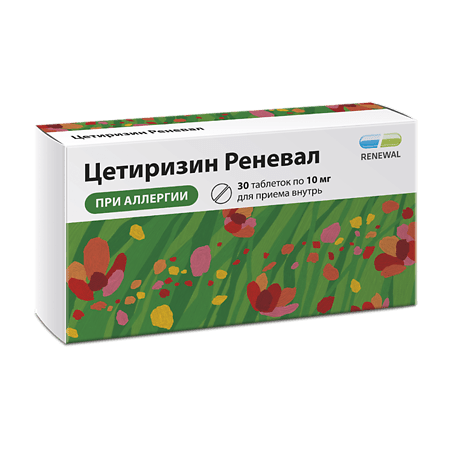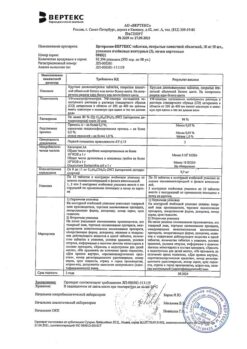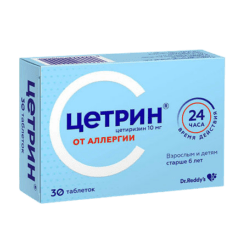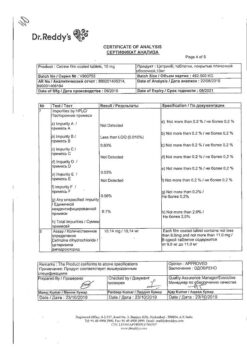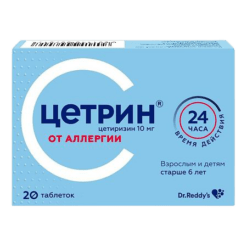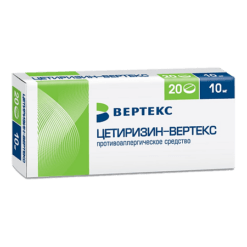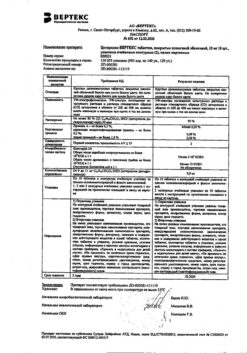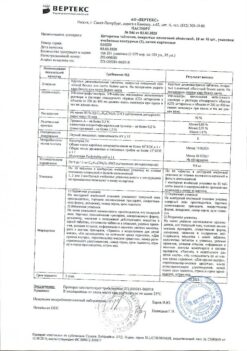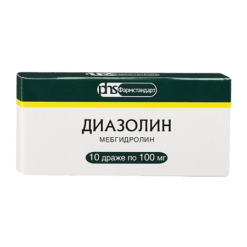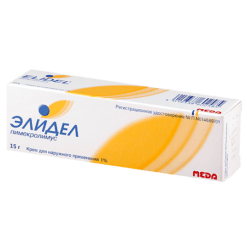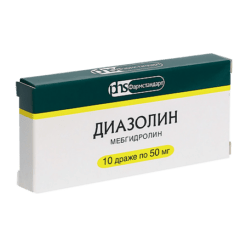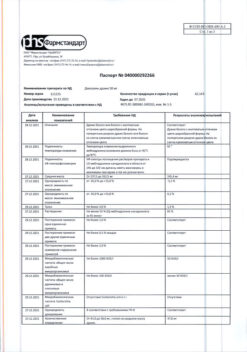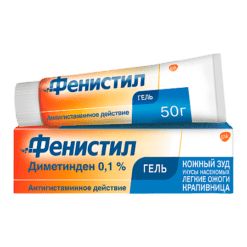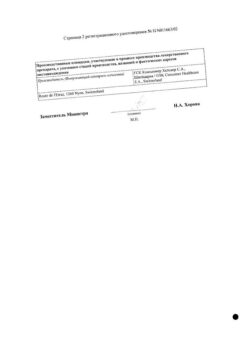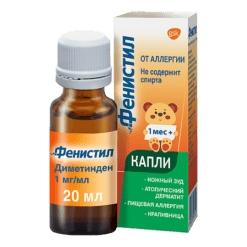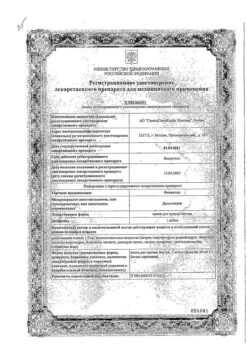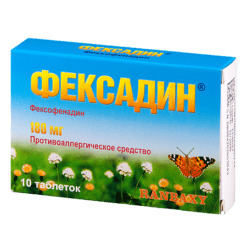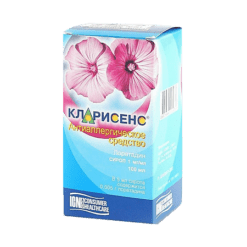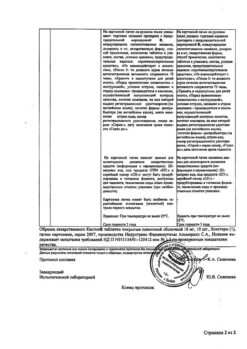No products in the cart.
Description
Pharmacotherapeutic group:anti-allergic agent – H1-histamine receptor blocker.
ATX code: R06AE07
Pharmacological properties
Mechanism of action
Cetirizine, the active ingredient of Cetirizine Reneval, is a metabolite of hydroxyzine and has an antihistamine effect with antiallergic action. Cetirizine belongs to the group of competitive histamine antagonists and blocks
H1-histamine receptors with little effect on other receptors,
and has almost no anticholinergic and antiserotonin action.
Cetirizine affects the histamine-dependent stage of immediate allergic reactions and also reduces the migration of eosinophils and limits the release of mediators in delayed-type allergic reactions. It practically does not pass through the blood-brain barrier and therefore is almost incapable of reaching central H1 receptors.
Pharmacodynamics
. In studies of the effects of histamine on the skin, the effects of cetirizine at a dose of 10 mg began after 1 hour, peaked from the 2nd to 12th hour, and were still observed at statistically significant levels after 24 hours. In addition to the antihistamine effect, cetirizine also has an anti-inflammatory
effect and thus has an effect on the late phase of the allergic reaction:
– at a dose of 10 mg once or twice daily, inhibits the late phase of eosinophil aggregation in the skin;
– at a dose of 30 mg daily, inhibits the release of eosinophils into the bronchial alveolar fluid after allergen-induced bronchial constriction;
-inhibits the kallikrein-induced late inflammatory response;
-inhibits the expression of inflammatory markers such as ICAM-1 or VCAM-1;
-inhibits the action of histaminoliberators such as PAF or Substance P.
Pharmacokinetics
Absorption
./p>
The drug is rapidly absorbed from the gastrointestinal tract after oral administration. The pharmacokinetic parameters of cetirizine when administered in doses from 5 to
60 mg vary linearly. The equilibrium concentration is reached after 3 days.
The pharmacokinetic profile of cetirizine is similar in adults and children. In children
after taking cetirizine at a dose of 5 mg, the concentration of the active substance in the body is the same as in adults after taking 10 mg. In adults after receiving cetirizine
in dose of 10 mg maximum concentration (Cmax) in blood plasma is reached after
1-2 hours and is 350 ng/ml. In children after administration of cetirizine at a dose of 5 mg
Cmax in plasma is reached after 1 hour and is 275 ng/ml.
When cetirizine is taken in the form of drops, maximum plasma concentrations are reached at a higher rate.
Distribution
Distribution after 10 mg administration is 35 liters in adults, and plasma protein binding is 93%. In children, the volume of distribution after administration of 5 mg is approximately 17 liters.
A small amount of cetirizine is excreted into breast milk.
Metabolism
In adults, 60% of the dose is excreted unchanged by the kidneys.
Elimation
After administration of 10 mg in adults, total clearance of cetirizine is 0.60 ml/min/kg; the half-life (T1/2) is approximately 10 hours. Administration of several
doses does not change the pharmacokinetic parameters. No cetirizine cumulation was observed when taking the drug in a daily
dose of 10 mg for 10 days.
After the end of treatment, plasma levels of cetirizine rapidly fall below detectable limits. Repeated allergy tests can be resumed after
3 days.
Separate patient groups
Elderly patients:
In 16 elderly individuals, the T1/2 was 50% higher at a single dose of 10 mg, and the excretion rate was 40% lower compared with the control group.
The decreased clearance of cetirizine in elderly patients is probably due to decreased renal function in this patient population.
Children:
In children aged 6 to 12 years, 70% of the dose is excreted unchanged by the kidneys.
After administration of 5 mg in children, the total clearance of cetirizine is 0.93 ml/min/kg.
T1/2 in children 6 to 12 years old is 6 hours, 2 to 6 years old is 5 hours.
Patients with renal insufficiency:
In patients with mild renal impairment (creatinine clearance
(CK) > 50 ml/min), pharmacokinetic parameters are similar
to those of healthy volunteers with normal renal function.
In patients with moderate renal impairment (CKD 30-49 ml/min), the T1/2 lengthens 3-fold and total clearance decreases by 70% relative to healthy volunteers with normal renal function.
In patients on hemodialysis (CK < 7 ml/min), oral administration of the drug
at a dose of 10 mg decreases total clearance by approximately 70%
relative to healthy volunteers with normal renal function, and the T1/2 lengthens
3-fold.
Less than 10% of cetirizine is removed by standard hemodialysis procedures.
Patients with hepatic insufficiency:
In patients with chronic liver disease (hepatocellular, cholestatic, and biliary cirrhosis), a single dose of
10 or 20 mg T1/2 is increased by approximately 50% and clearance is decreased by 40% compared to healthy subjects.
Dose adjustment is necessary only if a patient with hepatic impairment also has concomitant renal impairment.
Indications
Indications
The use of the drug is indicated in adults and children over 6 years of age to alleviate:
nasal and ocular symptoms of year-round (persistent) and seasonal (intermittent) allergic rhinitis and allergic conjunctivitis: itching, sneezing, nasal congestion, rhinorrhea, lacrimation, conjunctival hyperemia;
symptoms of chronic idiopathic urticaria.
Pharmacological effect
Pharmacological effect
Pharmacotherapeutic group: antiallergic agent – H1-histamine receptor blocker.
ATX code: R06AE07
Pharmacological properties
Mechanism of action
Cetirizine – the active substance of the drug Cetirizine Renewal – is a metabolite of hydroxyzine, has an antihistamine effect with an antiallergic effect. Cetirizine belongs to the group of competitive histamine antagonists and blocks
H1-histamine receptors with little effect on other receptors,
and has virtually no anticholinergic and antiserotonin effects.
Cetirizine has an effect on the histamine-dependent stage of immediate-acting allergic reactions, and also reduces the migration of eosinophils and limits the release of mediators in delayed-type allergic reactions. Almost does not pass the blood-brain barrier and, therefore, is almost unable to reach the central H1 receptors.
Pharmacodynamics
In studies of the effects of histamine on skin, the effects of cetirizine 10 mg began at 1 hour, peaked at 2 to 12 hours, and were still observed at statistically significant levels at 24 hours. In addition to its antihistamine effect, cetirizine also has anti-inflammatory properties.
effect and thereby influences the late phase of the allergic reaction:
– at a dose of 10 mg once or twice a day, inhibits the late phase of eosinophil aggregation in the skin;
– at a dose of 30 mg per day, inhibits the excretion of eosinophils into the bronchial alveolar fluid after allergen-induced bronchial constriction;
– inhibits the late inflammatory response caused by kallikrein;
– suppresses the expression of inflammatory markers such as ICAM-1 or VCAM-1;
– inhibits the action of histamine liberators such as PAF or substance P.
Pharmacokinetics
Suction
After oral administration, the drug is quickly absorbed from the gastrointestinal tract. Pharmacokinetic parameters of cetirizine when used in doses from 5 to
60 mg changes linearly. Equilibrium concentration is achieved after 3 days.
The pharmacokinetic profile of cetirizine is similar in adults and children. In children
after taking cetirizine at a dose of 5 mg, the concentration of the active substance in the body is the same as in adults after taking 10 mg. In adults after taking cetirizine
at a dose of 10 mg, the maximum concentration (Cmax) in blood plasma is achieved after
1-2 hours and is 350 ng/ml. In children after taking cetirizine at a dose of 5 mg
Cmax in blood plasma is reached after 1 hour and is 275 ng/ml.
When cetirizine is taken in the form of drops, maximum plasma concentrations are achieved at a higher rate.
Distribution
Distribution after taking 10 mg is 35 liters in adults, and binding to plasma proteins is 93%. In children, the volume of distribution after taking 5 mg is approximately 17 liters.
A small amount of cetirizine is excreted into breast milk.
Metabolism
In adults, 60% of the dose is excreted unchanged from the body by the kidneys.
Removal
After taking 10 mg in adults, the total clearance of cetirizine is 0.60 ml/min/kg; The half-life (T1/2) is approximately 10 hours. Reception of several
dose does not change pharmacokinetic parameters. When taking the drug in the daily allowance
At a dose of 10 mg for 10 days, no accumulation of cetirizine was observed.
After the end of treatment, the level of cetirizine in the blood plasma quickly falls below detectable limits. Repeated allergy tests can be resumed through
3 days.
Selected patient groups
Elderly patients:
In 16 elderly people, with a single dose of 10 mg, T1/2 was 50% higher, and the elimination rate was 40% lower compared to the control group.
The decreased clearance of cetirizine in elderly patients is likely due to decreased renal function in this category of patients.
Children:
In children aged 6 to 12 years, 70% of the dose is excreted unchanged from the body by the kidneys.
After taking 5 mg in children, the total clearance of cetirizine is 0.93 ml/min/kg.
T1/2 in children from 6 to 12 years old is 6 hours, from 2 to 6 years old – 5 hours.
Patients with renal failure:
In patients with mild renal failure (clearance
creatinine (CC) > 50 ml/min) pharmacokinetic parameters are similar
those in healthy volunteers with normal renal function.
In patients with moderate renal failure (creatinine clearance 30-49 ml/min), T1/2 is prolonged by 3 times, and total clearance is reduced by 70% relative to healthy volunteers with normal renal function.
In patients on hemodialysis (creatinine clearance <7 ml/min), when taking the drug
Orally at a dose of 10 mg, total clearance is reduced by approximately 70%
relatively healthy volunteers with normal renal function, and T1/2 is prolonged
3 times.
Less than 10% of cetirizine is removed during standard hemodialysis.
Patients with liver failure:
In patients with chronic liver diseases (hepatocellular, cholestatic and biliary cirrhosis) with a single dose of
10 or 20 mg T1/2 increases by approximately 50% and clearance decreases by 40% compared to healthy subjects.
Dose adjustment is only necessary if the patient with hepatic insufficiency also has concomitant renal insufficiency.
Special instructions
Special instructions
In patients with spinal cord injury, prostatic hyperplasia,
and also in the presence of other predisposing factors to urinary retention,
Caution is required as cetirizine may increase the risk of urinary retention.
In patients with renal failure, the dosage regimen of the drug should be adjusted (see section “Dosage and Administration”).
Due to a possible decrease in renal function in elderly patients, the dosage regimen of the drug should be adjusted (see section “Method of administration
and doses”).
Caution is recommended when using cetirizine concomitantly with alcohol, as cetirizine may cause increased drowsiness.
Caution should be observed in patients with epilepsy and increased convulsive readiness.
Before prescribing allergy tests, a three-day “washing out” period is recommended due to the fact that H1-histamine receptor blockers inhibit the development of skin allergic reactions.
Cetirizine Renewal film-coated tablets should not be administered to patients with hereditary galactose intolerance, lactase deficiency or glucose-galactose malabsorption syndrome.
Pruritus and/or urticaria may occur after cetirizine is discontinued,
even if these symptoms were absent at the beginning of treatment. In some cases
symptoms may be severe and require resumption of cetirizine. Symptoms disappear when cetirizine is resumed.
Children
Cetirizine Renewal film-coated tablets are contraindicated in children under 6 years of age, since this dosage form does not allow the use of an appropriate dosage for this age group. It is recommended to use the pediatric dosage form (oral drops).
Read the instructions carefully before you start using the drug. Save the instructions, you may need them again. If you have any questions, consult your doctor. The medicine you are being treated with is intended for
you personally and should not be given to others as it may cause harm to them even if they have the same symptoms as you.
Impact on the ability to drive vehicles and machinery
Cetirizine can lead to increased drowsiness, therefore, the drug Cetirizine Renewal may affect the ability to drive vehicles and machinery.
Active ingredient
Active ingredient
Cetirizine
Composition
Composition
Active ingredient:
cetirizine dihydrochloride 10,000 mg;
excipients:
microcrystalline cellulose 101,
lactose monohydrate, croscarmellose (croscarmellose sodium),
povidone K 30,
magnesium stearate,
colloidal silicon dioxide (Aerosil);
shell composition: OPADRY® II COMPLETE FILM COATING SYSTEM 85F48105 WHITE [polyvinyl alcohol (E1203), macrogol 3350 (polyethylene glycol), talc, titanium dioxide (E171)]
Pregnancy
Pregnancy
Pregnancy
Data on the use of cetirizine during pregnancy are limited
(300-1000 pregnancy outcomes). However, no cases of formation of
malformations, embryonic and neonatal toxicity with clear
cause-and-effect relationship.
Experimental studies on animals have not revealed any direct
or indirect adverse effects of cetirizine on the developing fetus
(including in the postnatal period), the course of pregnancy and childbirth.
During pregnancy, cetirizine can be prescribed after consultation with a doctor, if the expected benefit to the mother outweighs the potential risk
for the fetus.
Breastfeeding period
Cetirizine should not be used during breastfeeding, since cetirizine is excreted in breast milk. Cetirizine is excreted into breast milk in an amount of 25-90% of the concentration in the blood plasma, depending on the time of sampling after taking the drug. Adverse reactions associated with cetirizine may occur in infants. During breastfeeding, it is used after consultation with a doctor, if the expected benefit to the mother outweighs the potential risk to the child.
Fertility
Available data on the effects on human fertility are limited, but no adverse effects on fertility have been identified in animal studies.
Before using the drug if you are pregnant or think you might be
If you are pregnant, or are planning a pregnancy, you need to consult
with a doctor.
Contraindications
Contraindications
Hypersensitivity to cetirizine, hydroxyzine or other piperazine derivatives, as well as any other component of the drug;
end-stage renal failure (CC < 10 ml/min);
children under 6 years of age (for this dosage form);
hereditary galactose intolerance, lactase deficiency or syndrome
glucose-galactose malabsorption.
With caution
Chronic renal failure (with CC > 10 ml/min, dosage regimen adjustment is required);
elderly patients (with an age-related decrease in glomerular filtration);
epilepsy and patients with increased convulsive readiness;
patients with predisposing factors to urinary retention (see section
“Special instructions”);
when used simultaneously with alcohol (see section “Interaction
with other medicines”);
breastfeeding period;
pregnancy.
Side Effects
Side Effects
Data obtained from clinical studies
Review
The results of clinical studies have demonstrated that the use of
Cetirizine in recommended doses leads to the development of minor undesirable effects on the central nervous system, including drowsiness, fatigue, dizziness
and headache. In some cases, paradoxical stimulation of the central nervous system has been reported.
Despite the fact that cetirizine is a selective blocker of peripheral
H1 receptors and has virtually no anticholinergic effect, reported
about isolated cases of difficulty urinating, disturbances of accommodation and dry mouth.
Impaired liver function has been reported, accompanied by increased
liver enzyme activity and bilirubin levels. In most cases, adverse events resolved after discontinuation of cetirizine.
List of unwanted side effects
Data are available from double-blind, controlled clinical trials comparing cetirizine with placebo or other antihistamines used at recommended doses (10 mg one
once daily for cetirizine) in more than 3200 patients, based on which
reliable analysis of safety data can be carried out.
According to the results of the pooled analysis, in placebo-controlled studies with the use of cetirizine at a dose of 10 mg, the following adverse reactions were identified with a frequency of 1.0% or higher:
Adverse reactions (WHO terminology)
Cetirizine
(n = 3260)
Placebo (n = 3061)
General disorders and disorders at the injection site
Fatigue
1.63%
0.95%
Nervous system disorders
Dizziness
Headache
1.10%
7.42%
0.98%
8.07%
Gastrointestinal disorders
Abdominal pain
Dry mouth
Nausea
0.98%
2.09%
1.07%
1.08%
0.82%
1.14%
Mental disorders
Drowsiness
9.63%
5.00%
Respiratory, thoracic and mediastinal disorders
Pharyngitis
1.29%
1.34%
Although the incidence of drowsiness in the cetirizine group was higher than that of
in the placebo group, most cases of this adverse event were mild
or moderate severity. With an objective assessment carried out within the framework of
Other studies have confirmed that the use of cetirizine at the recommended daily dose in healthy young volunteers does not affect their daily activities.
Children
In placebo-controlled studies in children aged 6 months to 12 years, the following adverse reactions were identified with an incidence of 1% or higher:
Adverse reactions (WHO terminology)
Cetirizine
(n = 1656)
Placebo (n = 1294)
Gastrointestinal disorders
Diarrhea
1.0%
0.6%
Mental disorders
Drowsiness
1.8%
1.4%
Respiratory, thoracic and mediastinal disorders
Rhinitis
1.4%
1.1%
General disorders and disorders at the injection site
Fatigue
1.0%
0.3%
Post-registration experience
In addition to the adverse events identified during clinical trials and described above, the following adverse reactions were observed during post-registration use of the drug.
Adverse events are presented below by MedDRA organ system class
and frequency of development, based on data from post-registration use
drug.
The following
were used to assess the frequency of adverse reactions (ARs):
criteria: “uncommon” (≥ 1/1000, < 1/100); “rare” (≥ 1/10000, < 1/1000); "very rarely"
(< 1/10000); “frequency unknown” (cannot be estimated from available data).
Disorders of the blood and lymphatic system: very rarely – thrombocytopenia.
Immune system disorders: rarely – hypersensitivity reactions; very rarely – anaphylactic shock.
Metabolic and nutritional disorders: frequency unknown – increased appetite.
Mental disorders: infrequently – agitation; rarely – aggression, confusion
consciousness, depression, hallucinations; very rarely – tic; frequency unknown
– suicidal ideation, sleep disturbances (including nightmares).
Nervous system disorders: uncommon – paresthesia; rarely – convulsions;
very rarely – taste perversion, dyskinesia, dystonia, fainting, tremor;
frequency unknown – memory impairment, including amnesia, deafness.
Violations of the organ of vision: very rarely – disturbance of accommodation, blurred vision, nystagmus; frequency unknown – vasculitis.
Hearing and labyrinthine disorders: frequency unknown
– vertigo.
Cardiovascular system disorders: rarely – tachycardia.
Gastrointestinal disorders: uncommon – diarrhea.
Disorders of the liver and bile ducts: rarely – liver failure with changes in liver function tests (increased activity of transaminases, alkaline phosphatase, gamma-glutamyl transferase and bilirubin); frequency unknown – hepatitis.
Disorders of the skin and subcutaneous tissues: infrequently – rash, itching;
rarely – urticaria; very rarely – angioedema, persistent drug-induced erythema; frequency unknown – acute generalized exanthematous pustulosis.
Renal and urinary tract disorders: very rarely – dysuria,
enuresis; frequency unknown – urinary retention.
Musculoskeletal and connective tissue disorders: frequency unknown – arthralgia.
General disorders: uncommon – asthenia, malaise; rarely – peripheral edema.
Influence on the results of laboratory and instrumental studies: rarely
– increase in body weight.
Description of selected adverse reactions: after discontinuation of cetirizine, cases of itching (including intense itching) and/or urticaria have been reported.
If any of the side effects indicated in the instructions get worse, or
If you notice any other side effects not listed in the instructions, please let us know
about this to the doctor.
Interaction
Interaction
Concomitant use with azithromycin, cimetidine, erythromycin, ketoconazole or pseudoephedrine does not affect the pharmacokinetic parameters of cetirizine. No pharmacokinetic interactions were observed. According to in vitro tests, cetirizine does not interfere with the protein binding effect of warfarin.
Concomitant use of azithromycin, erythromycin, ketoconazole, theophylline and pseudoephedrine did not reveal significant changes in clinical laboratory parameters, vital signs and ECG. In a study with concomitant administration of theophylline (400 mg per day) and cetirizine (20 mg per day), a slight but statistically significant increase in 24-hour AUC (area
under the curve) by 19% for cetirizine and by 11% for theophylline. In addition, maximum plasma levels increased to 7.7% and 6.4%, respectively
for cetirizine and theophylline. At the same time, the clearance of cetirizine decreased by -16%,
and also by -10% in the case of theophylline, when patients took cetirizine,
who have previously received treatment with theophylline. However, pretreatment with cetirizine did not significantly affect the pharmacokinetic parameters of theophylline.
After a single dose of cetirizine 10 mg, the effect of alcohol (0.8% O) was not significantly enhanced; a statistically significant interaction with 5 mg diazepam was demonstrated in one of 16 psychometric tests.
Concomitant administration of 10 mg cetirizine per day with glipizide resulted in a slight decrease in glucose levels. This effect is not clinically significant.
However, separate administration is recommended – glipizide in the morning and cetirizine in the evening.
The degree of absorption of cetirizine is not reduced by simultaneous food intake,
although absorption slows down by 1 hour.
In a multiple dose study of ritonavir (600 mg twice daily) and cetirizine (10 mg daily), cetirizine exposure was increased by approximately
by 40%, while ritonavir exposure changed slightly
(-11%) due to concomitant use of cetirizine.
If you are using the above or other medications
(including over-the-counter medications) consult your doctor before using Cetirizine Renewal.
Overdose
Overdose
Symptoms
Symptoms observed after apparent drug overdose affected
central nervous system or have been associated with possible anticholinergic effects. Symptoms that were observed after taking at least
at least five times the recommended daily dose, included the following: confusion, diarrhea, fatigue, headache, malaise, mydriasis,
itching, anxiety, sedation, drowsiness, stupor, tachycardia, tremor,
urinary retention.
Treatment
There is no specific antidote.
In case of overdose, symptomatic or supportive treatment is recommended.
treatment. Gastric lavage and/or activated charcoal may be effective if the overdose has occurred recently. Cetirizine is partially eliminated by dialysis.
Storage conditions
Storage conditions
In the original packaging (blister pack in a pack) at a temperature
no higher than 30 °C.
Keep out of the reach of children.
Shelf life
Shelf life
3 years.
Do not use after expiration date.
Manufacturer
Manufacturer
Update of PFC JSC, Russia
Additional information
| Shelf life | 3 years. Do not use after the expiration date. |
|---|---|
| Conditions of storage | In the original package (in a box in a package) at a temperature not exceeding 30 °С. Keep out of reach of children. |
| Manufacturer | Update PFC AO, Russia |
| Medication form | pills |
| Brand | Update PFC AO |
Other forms…
Related products
Buy Cetirizine Reneval, 10 mg 30 pcs with delivery to USA, UK, Europe and over 120 other countries.

